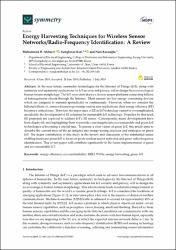Energy Harvesting Techniques for Wireless Sensor Networks/Radio-Frequency Identification: A Review
Abstract
In the near future, symmetry technologies for the Internet of Things (IoT), along with symmetry and asymmetry applications for IoT security and privacy, will re-design the socio-ecological human terrain morphology. The IoT ecosystem deploys diverse sensor platforms connecting billions of heterogeneous objects through the Internet. Most sensors are low-energy consuming devices which are designed to transmit sporadically or continuously. However, when we consider the billions/trillions of connected sensors powering various user applications, their energy efficiency (EE) becomes a critical issue. Therefore, the importance of EE in IoT technology cannot be overemphasised, specifically the development of EE solutions for sustainable IoT technology. Propelled by this need, EE proposals are expected to address IoT's EE issues. Consequently, many developments have been displayed, and highlighting them to provide clear insights into eco-sustainable and green IoT technologies is becoming a crucial task. To pursue a clear vision of green IoT, this article aims to describe the current state-of-the art insights into energy-saving practices and strategies on green IoT. The major contribution of this study is the review and discussion of the substantial issues enabling hardware green IoT to focus on green wireless sensor networks and green radio-frequency identification. This review paper will contribute significantly to the future implementation of green and eco-sustainable IoT.
Volume
11Issue
7Collections
The following license files are associated with this item:


















